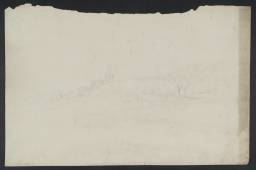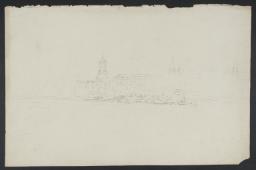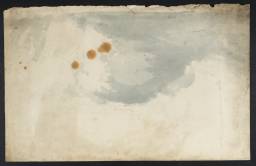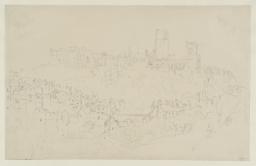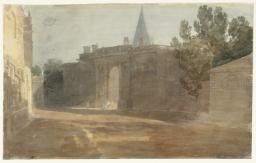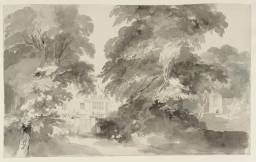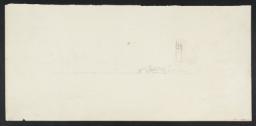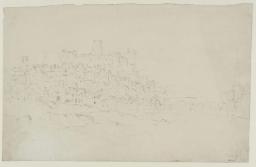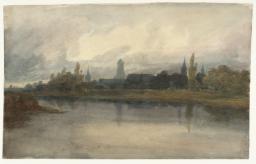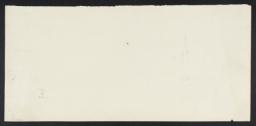Turner Bequest XLVIII 2, 3, 4, 5, 7, LXX g, CXXI G
Leaves from a sketchbook, disbound at an early date and now largely dispersed
7 leaves of white wove paper; approximate page size up to 271 x 416 mm; watermark ‘J Whatman 1794’
7 leaves of white wove paper; approximate page size up to 271 x 416 mm; watermark ‘J Whatman 1794’
Accepted by the nation as part of the Turner Bequest 1856
References
The few leaves from this sketchbook remaining in the Turner Bequest comprise views of Oxford from about 1798–9, with one of Durham made on the way to Scotland in 1801. The source of the book’s traditional name is unclear: Finberg called it the ‘“Smaller Fonthill” Sketch Book’,1 with the quotation marks he conventionally uses to indicate a transcription, though no covers or labels survive, so this may be a quirk of typography. There are extensive drawings of William Beckford’s Wiltshire house, Fonthill Abbey, in the course of construction in 1799 in the Fonthill sketchbook (Tate; Turner Bequest XLVII), addressed elsewhere in the present section of this catalogue. Included in this subsection are two sheets not associated with the Smaller Fonthill sketchbook by Finberg (D04184, D08262; Turner Bequest LXX g, CXXI G), respectively views of Durham and Oxford.
Conversely, some of the Smaller Fonthill drawings that remain in the Bequest are not by Turner, including the views at Fonthill itself.2 Fonthill: The Abbey from the South East (Tate D02236; Turner Bequest XLVIII 1)3 is in pencil, measuring 275 x 412 mm. At first sight it appears to be autograph; it is in fact somewhat tentative, and given that the sketches on the verso are almost certainly not in Turner’s hand it seems likely that the same artist was responsible for this view. Compare views of Fonthill by Turner himself in the Fonthill sketchbook. The verso (D40258) comprises Three Studies: Men Lifting Stones with a Pulley; a Horse; and a Gothic Window and Crenellation, also in pencil.4 Although not as accomplished, or as plausibly Turnerian, as the view of the house on the recto, these studies showing details of life during the building of Fonthill may be by the same hand, as may the following drawing.
A House among Trees (Tate D02241; Turner Bequest XLVIII 6)5 is in pencil with grey and blue-grey washes, measuring 254 x 414 mm. The verso is inscribed by John Ruskin in pencil ‘Mount & Frame | Original of Vignette to Italy | JR’. This is the most substantial of the Smaller Fonthill drawings that are clearly by a hand other than Turner’s. It is very likely by the author of the view of Fonthill discussed above, but its washes are clumsily handled, and quite unlike any use of that medium by Turner himself. Ruskin’s reasoning is difficult to reconstruct: he was presumably thinking of the vignette design known as An Old Manor-House (Tate D27718; Turner Bequest CCLXXX 201),6 engraved for the 1834 edition of Samuel Rogers’s Poems (Tate impressions: T05115, T06163), but must have made his observation from memory, since there is in reality little resemblance between the two images, and the house in the vignette is much more substantial. Finberg did not question Ruskin’s assumption of Turner’s authorship, and added the information that Ruskin had written on the ‘margin of mount’ (no longer extant): ‘Original of the Vignette to “Human Life”, Rogers. J.R.’7 This second inscription rectifies the error of the first, which had ascribed the ‘old manor house’ design to Italy (1830) rather than the Poems, but seems nevertheless to have been a comment made without checking the vignette itself. The seventeenth-century house in the Smaller Fonthill drawing has not been identified, but may be somewhere close to Fonthill, where the other amateur drawings seem to have been made.
Regarding another drawing previously associated with Turner, of Workmen at Fonthill (private collection), while some aspects of the execution (notably the large tree at the left) show a knowledge of his manner, the palette and use of coarse buff paper suggest an acquaintance with the work of Thomas Girtin (1775–1802) as well.
A checklist of the considerable number of Turner’s drawings identified as originating in the Smaller Fonthill book, but since dispersed to other collections, is given here. Most were made in the course of the tour to Scotland in 1801:
1. Merton College, Oxford, from the Meadows8
Watercolour on white wove paper, 255 x 400 mm
Provenance: J.E. Taylor; Agnew’s, London; J.E.T. Allen
Private collection
Watercolour on white wove paper, 255 x 400 mm
Provenance: J.E. Taylor; Agnew’s, London; J.E.T. Allen
Private collection
2. Barges on a River or Canal near a Mine
Pencil on white wove paper, 264 x 415 mm
British Museum, London (1946,1109.3; Mrs A.J. Finberg gift)
Pencil on white wove paper, 264 x 415 mm
British Museum, London (1946,1109.3; Mrs A.J. Finberg gift)
3. Industrial Machinery beside a River or Canal, with Barges
Pencil on white wove paper, 262 x 413 mm
Verso inscribed ‘Pencil drawing by J M W Turner Page from “Smaller Fonthill” SK. BK. (T. B. XLVIII) Probably a scene on the Tyne’
British Museum, London (1946,1109.4; Mrs A.J. Finberg gift)
Pencil on white wove paper, 262 x 413 mm
Verso inscribed ‘Pencil drawing by J M W Turner Page from “Smaller Fonthill” SK. BK. (T. B. XLVIII) Probably a scene on the Tyne’
British Museum, London (1946,1109.4; Mrs A.J. Finberg gift)
4. A Canal Tunnel near Leeds9
Watercolour and ink on white wove paper, 241 x 400 mm
Provenance: Mrs Newall; Mavis Strange; Richard Ivor, London; Andrew Wyld, London
Exhibited: English Watercolours, Drawings and Oil Paintings from Gainsborough to Turner, Andrew Wyld, London 1985 (14)
Private collection
Watercolour and ink on white wove paper, 241 x 400 mm
Provenance: Mrs Newall; Mavis Strange; Richard Ivor, London; Andrew Wyld, London
Exhibited: English Watercolours, Drawings and Oil Paintings from Gainsborough to Turner, Andrew Wyld, London 1985 (14)
Private collection
5. The Coast of Yorkshire, near Whitby10
Pencil on white wove paper, 263 x 410 mm
Provenance: John Ruskin
Ashmolean Museum, Oxford (Ruskin School Collection)
Pencil on white wove paper, 263 x 410 mm
Provenance: John Ruskin
Ashmolean Museum, Oxford (Ruskin School Collection)
6. View of the Coast Looking towards a Ruined Abbey [?Whitby]11
Pencil and watercolour on white wove paper, 255 x 405 mm
Provenance: sale Sotheby’s, London, 15 March 1984 (134)
Private collection
Pencil and watercolour on white wove paper, 255 x 405 mm
Provenance: sale Sotheby’s, London, 15 March 1984 (134)
Private collection
7. Whitby Harbour; verso: slight pencil scribble
Pencil on white wove paper, 265 x 414 mm
Fogg Museum, Cambridge, Massachusetts (1907.7; James Loeb gift)
Pencil on white wove paper, 265 x 414 mm
Fogg Museum, Cambridge, Massachusetts (1907.7; James Loeb gift)
8. Brinkburn Priory
Pencil on white wove paper, 267 x 415 mm
Fogg Museum, Cambridge, Massachusetts (1907.12; James Loeb gift)
Pencil on white wove paper, 267 x 415 mm
Fogg Museum, Cambridge, Massachusetts (1907.12; James Loeb gift)
9. Rievaulx Abbey
Pencil on white wove paper 265 x 415 mm
Museum of Fine Arts, Boston (23.1237; William Norton Bullard gift)
Pencil on white wove paper 265 x 415 mm
Museum of Fine Arts, Boston (23.1237; William Norton Bullard gift)
The basis for the Liber Studiorum plate, published in 1812 (Tate impressions: A01012–A01014); see the entry for the watercolour design, Tate D08154 (Turner Bequest CXVII Z).13
10. Durham
Pencil on white wove paper, 415 x 260 mm
Fogg Museum, Cambridge, Massachusetts (1907.8; James Loeb gift)
Pencil on white wove paper, 415 x 260 mm
Fogg Museum, Cambridge, Massachusetts (1907.8; James Loeb gift)
11. ?Warkworth Castle
Pencil on white wove paper, 263 x 418 mm
Fogg Museum, Cambridge, Massachusetts (1907.13; James Loeb gift)
Pencil on white wove paper, 263 x 418 mm
Fogg Museum, Cambridge, Massachusetts (1907.13; James Loeb gift)
12. Village and Bridge in Middle Distance
Pencil on white wove paper, 264 x 412 mm
Provenance: Miss Griffiths; Francis Bullard
Fogg Museum, Cambridge, Massachusetts (1921.16; Ellen Bullard gift)
Pencil on white wove paper, 264 x 412 mm
Provenance: Miss Griffiths; Francis Bullard
Fogg Museum, Cambridge, Massachusetts (1921.16; Ellen Bullard gift)
13. ?Fall of the Tees (‘Fall of the Clyde’)
Pencil on white wove paper, 419 x 265 mm; watermark ‘1794’
Fogg Museum, Cambridge, Massachusetts (1907.10; James Loeb gift)
Pencil on white wove paper, 419 x 265 mm; watermark ‘1794’
Fogg Museum, Cambridge, Massachusetts (1907.10; James Loeb gift)
Sometimes known as ‘The Little Devil’s Bridge’. If this is indeed related to the subject of the 1809 Liber Studiorum plate (Tate impressions: A00947–A00949; see the entry for the watercolour design, Tate D08123; Turner Bequest CXVI V), which is in a horizontal, not vertical format, it is the only Smaller Fonthill sheet to have been identified as a scene on the Continent. The assumption must be that this is an inaccurate title, and that the view is of a Scottish waterfall, perhaps the ‘Rumbling Bridge’ near Dunkeld in Perthshire.
14. Scarborough Castle
Pencil on white wove paper, 263 x 414 mm
Leeds Art Gallery (1369/38; Sydney D. Kitson bequest 1938)
Pencil on white wove paper, 263 x 414 mm
Leeds Art Gallery (1369/38; Sydney D. Kitson bequest 1938)
15. Scarborough Castle14
Watercolour on white wove paper, 254 x 400 mm
Provenance: E.J. Taylor; T.A. Tatton; Mrs Crabtree; W.W. Williams; Christie’s, London, 21 November 2007 (28)
Private collection
Watercolour on white wove paper, 254 x 400 mm
Provenance: E.J. Taylor; T.A. Tatton; Mrs Crabtree; W.W. Williams; Christie’s, London, 21 November 2007 (28)
Private collection
16. Scarborough15
Pencil and watercolour on white wove paper, 258 x 411 mm
Provenance: John Ruskin
Ashmolean Museum, Oxford (Ruskin School Collection)
Pencil and watercolour on white wove paper, 258 x 411 mm
Provenance: John Ruskin
Ashmolean Museum, Oxford (Ruskin School Collection)
17. Durham Castle, with the Cathedral Beyond16
Pencil and watercolour on white wove paper, 392 x 268 mm
Provenance: Sir Hickman Bacon
Private collection
Pencil and watercolour on white wove paper, 392 x 268 mm
Provenance: Sir Hickman Bacon
Private collection
18. Durham Castle17
Pencil and watercolour on white wove paper, 410 x 250 mm
Provenance: Thomas Griffith; A.J. Finberg; Miss Lupton
Leeds Art Gallery (5.225/52; Agnes and Norman Lupton bequest 1952)
Pencil and watercolour on white wove paper, 410 x 250 mm
Provenance: Thomas Griffith; A.J. Finberg; Miss Lupton
Leeds Art Gallery (5.225/52; Agnes and Norman Lupton bequest 1952)
19. Durham Cathedral18
Pencil and watercolour on white wove paper, 410 x 248 mm
National Galleries of Scotland, Edinburgh (D NG 889; Henry Vaughan bequest 1900)
Pencil and watercolour on white wove paper, 410 x 248 mm
National Galleries of Scotland, Edinburgh (D NG 889; Henry Vaughan bequest 1900)
20. Durham Castle and Bridge19
Pencil on white wove paper, 366 x 263 mm
Provenance: John Ruskin
Ashmolean Museum, Oxford (Ruskin School Collection)
Pencil on white wove paper, 366 x 263 mm
Provenance: John Ruskin
Ashmolean Museum, Oxford (Ruskin School Collection)
Compare the drawing in the 1801 Helmsley sketchbook (Tate D02505–D02506; Turner Bequest LIII 26a–27 recto).
21. Durham Cathedral from across the River
Pencil on white wove paper, 246 x 413 mm
Leeds Art Gallery (5.227/52; Agnes and Norman Lupton bequest 1952)
Pencil on white wove paper, 246 x 413 mm
Leeds Art Gallery (5.227/52; Agnes and Norman Lupton bequest 1952)
22. Landscape with Bridge and Castle (‘Linlithgow Palace, Scotland’)20
Pencil and watercolour on white wove paper, 265 x 413 mm
Indianapolis Museum of Art (13.443; John Herron Fund)
Pencil and watercolour on white wove paper, 265 x 413 mm
Indianapolis Museum of Art (13.443; John Herron Fund)
23. Tantallon Castle21
Pencil on white wove paper, 412 x 255 mm
Princeton University Art Museum (43–214; Frank Jewett Mather, Jr gift)
Pencil on white wove paper, 412 x 255 mm
Princeton University Art Museum (43–214; Frank Jewett Mather, Jr gift)
24. Edinburgh from below Arthur’s Seat (‘Edinburgh from above Duddingston’)22
Watercolour on white wove paper, 258 x 411 mm
National Gallery of Ireland, Dublin (NGI 2410; Henry Vaughan bequest 1900)
Watercolour on white wove paper, 258 x 411 mm
National Gallery of Ireland, Dublin (NGI 2410; Henry Vaughan bequest 1900)
25. Edinburgh from Calton Hill
Pencil on white wove paper, 250 x 405 mm
Provenance: Sotheby’s, London, 11 November 1982 (47), bought Leger (with no.31 below)
Private collection
Pencil on white wove paper, 250 x 405 mm
Provenance: Sotheby’s, London, 11 November 1982 (47), bought Leger (with no.31 below)
Private collection
26. Edinburgh from St Anthony’s Chapel
Pencil on white wove paper, 265 x 416 mm
Fogg Museum, Cambridge, Massachusetts (1907.4; James Loeb gift)
Pencil on white wove paper, 265 x 416 mm
Fogg Museum, Cambridge, Massachusetts (1907.4; James Loeb gift)
27. Edinburgh Castle
Pencil on white wove paper, 262 x 412 mm
Fogg Museum, Cambridge, Massachusetts (1917.66; purchase)
Pencil on white wove paper, 262 x 412 mm
Fogg Museum, Cambridge, Massachusetts (1917.66; purchase)
28. Linlithgow Palace24
Pencil and watercolour on white wove paper, 245 x 400 mm
Provenance: John Ruskin; Arthur Severn; Sir Thomas Barlow
National Gallery of Victoria, Melbourne (Barlow gift through the National Gallery Society)
Pencil and watercolour on white wove paper, 245 x 400 mm
Provenance: John Ruskin; Arthur Severn; Sir Thomas Barlow
National Gallery of Victoria, Melbourne (Barlow gift through the National Gallery Society)
29. Linlithgow
Pencil on white wove paper, 264 x 415 mm
Fogg Museum, Cambridge, Massachusetts (1907.5; James Loeb gift)
Pencil on white wove paper, 264 x 415 mm
Fogg Museum, Cambridge, Massachusetts (1907.5; James Loeb gift)
30. Linlithgow
Pencil on white wove paper, 264 x 413 mm
Verso inscribed by ?Turner in pencil ‘Mr [?Girtin] 20 [?gm]’
Fogg Museum, Cambridge, Massachusetts (1971.110; Arthur Pope gift)
Pencil on white wove paper, 264 x 413 mm
Verso inscribed by ?Turner in pencil ‘Mr [?Girtin] 20 [?gm]’
Fogg Museum, Cambridge, Massachusetts (1971.110; Arthur Pope gift)
31. A Distant View of Stirling
Pencil on white wove paper, 250 x 405 mm; watermark ‘J Whatman 1794’
Provenance: Sotheby’s, London, 11 November 1982 (47), bought Leger (with no. 25 above)
Private collection
Pencil on white wove paper, 250 x 405 mm; watermark ‘J Whatman 1794’
Provenance: Sotheby’s, London, 11 November 1982 (47), bought Leger (with no. 25 above)
Private collection
32. Stirling
Pencil on white wove paper, 264 x 412 mm
Exhibited: Drawings by the Late J.M.W. Turner, R.A., Fine Art Society, London 1878 (88)
Fogg Museum, Cambridge, Massachusetts (1907.6; James Loeb gift)
Pencil on white wove paper, 264 x 412 mm
Exhibited: Drawings by the Late J.M.W. Turner, R.A., Fine Art Society, London 1878 (88)
Fogg Museum, Cambridge, Massachusetts (1907.6; James Loeb gift)
33. Stirling Castle
Pencil on white wove paper, 262 x 413 mm
Verso: inscribed by a later hand in pencil ‘J M W Turner’
Private collection
Pencil on white wove paper, 262 x 413 mm
Verso: inscribed by a later hand in pencil ‘J M W Turner’
Private collection
34. Clouds and Hills at Inverary25
Pencil and grey wash on white wove paper, 260 x 411 mm
Provenance: John Ruskin
Exhibited: Turner in Scotland, Aberdeen Art Gallery and Museum, October–December 1982 (13)
Ashmolean Museum, Oxford (Ruskin School Collection)
Pencil and grey wash on white wove paper, 260 x 411 mm
Provenance: John Ruskin
Exhibited: Turner in Scotland, Aberdeen Art Gallery and Museum, October–December 1982 (13)
Ashmolean Museum, Oxford (Ruskin School Collection)
35. Jedburgh (‘Durham Castle from a Distance’)
Pencil on white wove paper, 264 x 414 mm
Fogg Museum, Cambridge, Massachusetts (1907.14; James Loeb gift)
Pencil on white wove paper, 264 x 414 mm
Fogg Museum, Cambridge, Massachusetts (1907.14; James Loeb gift)
36. Loch Leven Castle
Pencil on white wove paper (416 x 251 mm); watermark ‘1794’
Inscribed by John Ruskin on a label ‘(J. Ruskin) | Brantwood 1880 | I believe Loch Leven; Early sketch of JMWT. The record on back looks like a note of moulding I believe it to be his. Certainly not mine!’
Museum of Fine Arts, Boston (23.1239; William Norton Bullard gift)
Pencil on white wove paper (416 x 251 mm); watermark ‘1794’
Inscribed by John Ruskin on a label ‘(J. Ruskin) | Brantwood 1880 | I believe Loch Leven; Early sketch of JMWT. The record on back looks like a note of moulding I believe it to be his. Certainly not mine!’
Museum of Fine Arts, Boston (23.1239; William Norton Bullard gift)
37. Roslin Castle
Pencil on white wove paper, 415 x 265 mm
Fogg Museum, Cambridge, Massachusetts (1925.3, purchase)
Pencil on white wove paper, 415 x 265 mm
Fogg Museum, Cambridge, Massachusetts (1925.3, purchase)
38. Looking up at Roslin Castle (Hawthornden)
Pencil on white wove paper, 262 x 410 mm
Provenance: John Ruskin; sale Christie’s, London, 7 July 2010 (395)
Exhibited: Drawings by the Late J.M.W. Turner, R.A., Fine Art Society, London 1878 (91)
Private collection
Pencil on white wove paper, 262 x 410 mm
Provenance: John Ruskin; sale Christie’s, London, 7 July 2010 (395)
Exhibited: Drawings by the Late J.M.W. Turner, R.A., Fine Art Society, London 1878 (91)
Private collection
39. Dunblane Cathedral26
Pencil on white wove paper, 261 x 404 mm
Provenance: John Ruskin
Exhibited: Turner in Scotland, Aberdeen Art Gallery and Museum, October–December 1982 (29)
Ashmolean Museum, Oxford (Ruskin School Collection)
Pencil on white wove paper, 261 x 404 mm
Provenance: John Ruskin
Exhibited: Turner in Scotland, Aberdeen Art Gallery and Museum, October–December 1982 (29)
Ashmolean Museum, Oxford (Ruskin School Collection)
40. Dunblane Cathedral
Pencil on white wove paper, 267 x 413 mm
Exhibited: Turner in Scotland, Aberdeen Art Gallery and Museum, October–December 1982 (30)
Dunblane Cathedral (presented by the Society of Friends of Dunblane Cathedral 1963)
Pencil on white wove paper, 267 x 413 mm
Exhibited: Turner in Scotland, Aberdeen Art Gallery and Museum, October–December 1982 (30)
Dunblane Cathedral (presented by the Society of Friends of Dunblane Cathedral 1963)
41. Dunblane Cathedral (‘Durham’)
Pencil on white wove paper, 412 x 263 mm
Museum of Fine Arts, Boston (23.1238; William Norton Bullard gift)
Pencil on white wove paper, 412 x 263 mm
Museum of Fine Arts, Boston (23.1238; William Norton Bullard gift)
42. Fall of the Clyde
Pencil on white wove paper, 413 x 265 mm
Leeds City Art Gallery (13.213/53; Agnes and Norman Lupton bequest 1952)
Pencil on white wove paper, 413 x 265 mm
Leeds City Art Gallery (13.213/53; Agnes and Norman Lupton bequest 1952)
43. Fall of the Clyde27
Pencil and watercolour on white wove paper (two sheets joined down centre), 413 x 521 mm
National Galleries of Scotland, Edinburgh (D NG 886; Henry Vaughan bequest 1900)
Pencil and watercolour on white wove paper (two sheets joined down centre), 413 x 521 mm
National Galleries of Scotland, Edinburgh (D NG 886; Henry Vaughan bequest 1900)
44. Fall of the Clyde28
Pencil and watercolour on white wove paper, 382 x 255 mm
Provenance: A.J. Rowe; Agnew’s, London
Indianapolis Museum of Art (1996.169; Kurt F. Pantzer bequest 1979)
Pencil and watercolour on white wove paper, 382 x 255 mm
Provenance: A.J. Rowe; Agnew’s, London
Indianapolis Museum of Art (1996.169; Kurt F. Pantzer bequest 1979)
45. Fall of the Clyde29
Pencil and watercolour on white wove paper, 415 x 259 mm
Fogg Museum, Cambridge, Massachusetts (1907.9, James Loeb gift)
Pencil and watercolour on white wove paper, 415 x 259 mm
Fogg Museum, Cambridge, Massachusetts (1907.9, James Loeb gift)
46. Study of Rocks at the Fall of Clyde; verso: ?The Fall of Clyde
Pencil on white wove paper, 413 x 264 mm
British Museum, London (1946,1109.1; Mrs A.J. Finberg gift)
Pencil on white wove paper, 413 x 264 mm
British Museum, London (1946,1109.1; Mrs A.J. Finberg gift)
47. Foliage and Rocks ?at the Fall of Clyde
Pencil and grey wash on white wove paper, 415 x 264 mm
British Museum, London (1946,1109.2; Mrs A.J. Finberg gift)
Pencil and grey wash on white wove paper, 415 x 264 mm
British Museum, London (1946,1109.2; Mrs A.J. Finberg gift)
48. Ben Venue
Pencil on white wove paper, 264 x 415 mm; watermark ‘Whatman 1794’
Fogg Museum, Cambridge, Massachusetts (1907.11; James Loeb gift)
Pencil on white wove paper, 264 x 415 mm; watermark ‘Whatman 1794’
Fogg Museum, Cambridge, Massachusetts (1907.11; James Loeb gift)
49. Solway Moss30
Pencil on white wove paper, 255 x 413 mm
Provenance: John Ruskin
Exhibited: Turner in Scotland, Aberdeen Art Gallery and Museum, October–December 1982 (34)
Ashmolean Museum, Oxford (Ruskin School Collection)
Pencil on white wove paper, 255 x 413 mm
Provenance: John Ruskin
Exhibited: Turner in Scotland, Aberdeen Art Gallery and Museum, October–December 1982 (34)
Ashmolean Museum, Oxford (Ruskin School Collection)
The basis for the Liber Studiorum plate, published in 1816 (Tate impressions: A01015, A01188); see also the drawing in the Scotch Lakes sketchbook, Tate D03259–D03260 (Turner Bequest LVI 176a–177).
50. Solway Moss
Pencil and grey wash on white wove paper, 261 x 412 mm
Fogg Museum, Cambridge, Massachusetts (1907.16; James Loeb gift)
Pencil and grey wash on white wove paper, 261 x 412 mm
Fogg Museum, Cambridge, Massachusetts (1907.16; James Loeb gift)
51. A Highland Valley; verso: View along a Valley
Pencil on white wove paper, 263 x 413 mm; verso 413 x 263 mm
Museum of Fine Arts, Boston (23.1236; William Norton Bullard gift)
Pencil on white wove paper, 263 x 413 mm; verso 413 x 263 mm
Museum of Fine Arts, Boston (23.1236; William Norton Bullard gift)
This subject may be half of a drawing on a double spread of the sketchbook.
52. Landscape with a Ruined Castle
Pencil on white wove paper, 264 x 411 mm; watermark ‘Whatman 1794’
Provenance: J.E. Taylor; Stephen Bullard, Boston
Museum of Fine Arts, Boston (59.792; Ellen Twistleton Bullard bequest)
Pencil on white wove paper, 264 x 411 mm; watermark ‘Whatman 1794’
Provenance: J.E. Taylor; Stephen Bullard, Boston
Museum of Fine Arts, Boston (59.792; Ellen Twistleton Bullard bequest)
This castle may be the same as that shown in a series of drawings in the Dunbar sketchbook, including Tate D02657 (Turner Bequest LIV 38). It seems to recur in the next two drawings.
53. ?Another View of the Same Castle
Pencil on white wove paper
Inscribed by John Ruskin in black ink ‘J.M.W.T. – Early – in Scotland very fine of its kind (J Ruskin 1880)’ bottom right
Museum of Fine Arts, Boston (07.860; Denman Waldo Ross gift)
Pencil on white wove paper
Inscribed by John Ruskin in black ink ‘J.M.W.T. – Early – in Scotland very fine of its kind (J Ruskin 1880)’ bottom right
Museum of Fine Arts, Boston (07.860; Denman Waldo Ross gift)
54. Another View of the Same Castle; verso: Shore Scene
Pencil on white wove paper, 265 x 415 mm; verso pencil with grey wash
Inscribed by John Ruskin in black ink ‘J.M.W.T. back to front, all superb, early time. J Ruskin Brantwood 1880’ bottom left
Provenance: J.E. Taylor
Museum of Fine Arts, Boston (07.859; Denman Waldo Ross gift)
Pencil on white wove paper, 265 x 415 mm; verso pencil with grey wash
Inscribed by John Ruskin in black ink ‘J.M.W.T. back to front, all superb, early time. J Ruskin Brantwood 1880’ bottom left
Provenance: J.E. Taylor
Museum of Fine Arts, Boston (07.859; Denman Waldo Ross gift)
55. ?Coniston Fells; verso: A Waterfall31
Pencil and watercolour on white wove paper, 252 x 415 mm (verso pencil)
Whitworth Art Gallery, Manchester (D.93.1892; J.E. Taylor gift)
Pencil and watercolour on white wove paper, 252 x 415 mm (verso pencil)
Whitworth Art Gallery, Manchester (D.93.1892; J.E. Taylor gift)
The subject is uncertain, but may represent Coniston Fells from ‘somewhere between Windermere and Coniston’.32 If so, this is the only leaf from the Smaller Fonthill book to show a subject in north-west England.
The notes on the two Smaller Fonthill leaves and Workmen at Fonthill which follow are based on Andrew Wilton’s draft entries for Turner Bequest works which are not by Turner, edited for the present context by Matthew Imms in February 2015.
Finberg 1909, I, p.123, XLVIII 1, as ‘Distant view of Fonthill Abbey, with unfinished tower’, c.1799–1802.
Ibid., under XLVIII 1, as ‘On back – Various small sketches – Back view of horse, a window and turrets, a group of men hoisting large stone blocks’.
Luke Herrmann, Ruskin and Turner: A Study of Ruskin as a Collector of Turner, Based on his Gifts to the University of Oxford; Incorporating a Catalogue Raisonné of the Turner Drawings in the Ashmolean Museum, London 1968, pp.89–90 no.66, as 1801, Pl.XLII d; see also Finberg 1909, I, p.123.
See also Gillian Forrester, Turner’s ‘Drawing Book’: The Liber Studiorum, exhibition catalogue, Tate Gallery, London 1996, p.113.
Herrmann 1968, p.90 no.69, pl.XLII i, as 1801; Wilton 1979, pp.335–6 no.318, reproduced, as 1801; see also Finberg 1909, I, p.124.
Ibid., p.335 no.316, reproduced, as c.1801; see also Finberg 1909, I, p.124; see also Christopher Baker, J.M.W. Turner: The Vaughan Bequest, Edinburgh 2006, pp.38, 110 no.6, reproduced in colour p.[39].
Wilton 1979, p.336 no.326, reproduced, as c.1800; see also Martin F. Krause, Turner in Indianapolis: The Pantzer Collection of Drawings and Watercolors by J.M.W. Turner and his Contemporaries at the Indianapolis Museum of Art, Indianapolis 1997, pp.100–3 no.27, reproduced (colour).
Ibid., p.336 no.320, reproduced, as c.1800; see also Finberg 1909, I, p.124, and Anne Hodge and Niamh Mac Nally, The Works of J.M.W. Turner at the National Gallery of Ireland, Dublin 2012, pp.56–7, reproduced in colour.
Wilton 1979, p.336 no.322, reproduced, as 1801; see also Finberg 1909, I, p.124, and Baker 2006, pp.40, 110 no.7, reproduced in colour p.[41].
How to cite
Andrew Wilton, ‘Leaves from the ‘Smaller Fonthill’ Sketchbook ?1798–1801’, sketchbook, May 2013, revised by Matthew Imms, February 2015, in David Blayney Brown (ed.), J.M.W. Turner: Sketchbooks, Drawings and Watercolours, Tate Research Publication, May 2016, https://www

